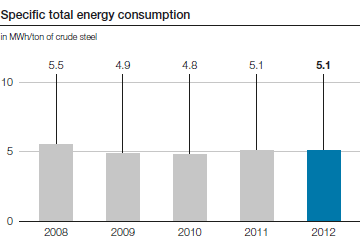Especially in the integrated metallurgical facilities, improved energy efficiency is achieved through optimization of process gases, increased thermal recycling of these gases, and utilization of waste heat potential. Numerous smaller projects are also being implemented at the individual locations, for example, switching to LED lighting or using electrically operated forklifts.
Group-wide, total specific energy consumption by voestalpine in the 2012 calendar year was 5.1 MWh/ton of crude steel. This corresponds to a reduction of around 10 % compared to the 2008 calendar year.
The absolute energy requirement in 2012 was at around 38 TWh for the entire Group.
After a number of expansions and renovations of their own power plants at the Linz und Donawitz sites, these sites are practically independent with regard to generation of electricity.
City heating network for the City of Leoben
Large amounts of process gas, such as blast furnace gas and steel mill converter gas, are generated during the production of pig iron and steel by voestalpine Stahl Donawitz. In the past, only part of these gases could be used for the generation of electricity. It was also not possible to completely utilize the waste heat from the rolling mill’s furnaces.
In 2008/09, the existing power plant was modernized and a new power plant unit was built, which is operated with process gases. At the same time, recovery facilities were built to supply the City of Leoben with district heating. By way of low pressure steam extraction by the two new steam turbines and using heat recovered from various thermal processes, voestalpine Stahl Donawitz has been able to supply the City of Leoben with waste heat of up to 50 MW thermal since 2009.
This generated the following ecological and economic benefits: better utilization of the blast furnace gas and steel mill converter gas, which are by-products created by the production of steel. Provision of cost-effective heat for the city and reduction of the CO2 emissions in Leoben by about 30,000 tons per year.
Energy concept of the Zeltweg site
In order to reduce energy consumption and, in turn, to lower CO2 emissions, voestalpine VAE, voestalpine Weichensysteme, and voestalpine HYTRONICS have taken joint measures to effect a total CO2 reduction by 1,200 tons/year. The central electronic energy and building management system that manages and monitors electricity, heating, and compressed air made a significant contribution to this achievement. Furthermore, 75% of the energy needed for heating was converted from natural gas to district heating. The integrated city heating system is fueled by biomass consisting of materials that cannot be recycled or otherwise utilized, for example, tree bark and debris such as branches and treetops.
Additionally, a small hydropower plant was erected on the Pöls River that supplies the Zeltweg site with carbon-free electricity generated by hydropower. Electricity not needed by voestalpine is fed into the grid.
The site had a positive carbon footprint for the first time in 2010. New investments will continue to improve the energy mix at the Zeltweg site.

